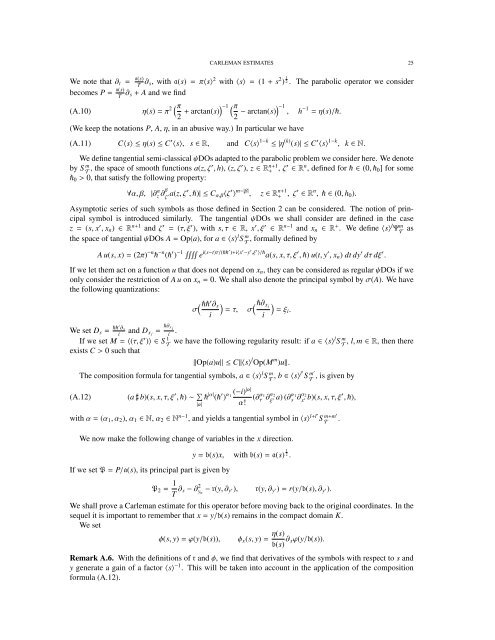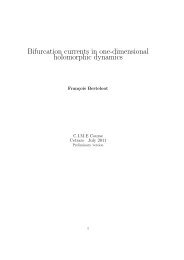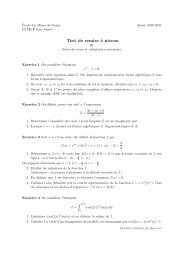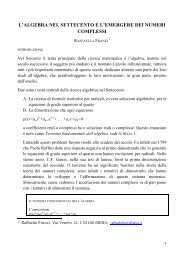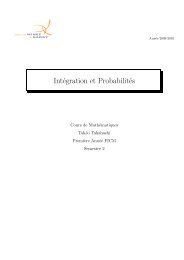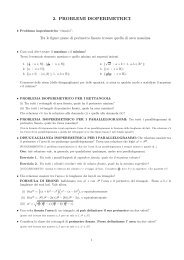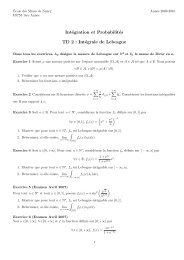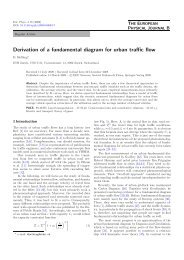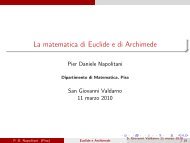on carleman estimates for elliptic and parabolic operators ...
on carleman estimates for elliptic and parabolic operators ...
on carleman estimates for elliptic and parabolic operators ...
Create successful ePaper yourself
Turn your PDF publications into a flip-book with our unique Google optimized e-Paper software.
CARLEMAN ESTIMATES 25<br />
We note that ∂ t T ∂ s, with a(s) = π〈s〉 2 with 〈s〉 = (1 + s 2 ) 1 2 . The <strong>parabolic</strong> operator we c<strong>on</strong>sider<br />
becomes P = a(s)<br />
T ∂ s + A <strong>and</strong> we find<br />
= a(s)<br />
η(s) = π ( 2 π<br />
2 + arctan(s)) −1 ( π<br />
2 − arctan(s)) −1<br />
(A.10)<br />
, h −1 = η(s)/ħ.<br />
(We keep the notati<strong>on</strong>s P, A, η, in an abusive way.) In particular we have<br />
(A.11)<br />
C〈s〉 ≤ η(s) ≤ C ′ 〈s〉, s ∈ R, <strong>and</strong> C〈s〉 1−k ≤ |η (k) (s)| ≤ C ′ 〈s〉 1−k , k ∈ N.<br />
We define tangential semi-classical ψDOs adapted to the <strong>parabolic</strong> problem we c<strong>on</strong>sider here. We denote<br />
by S m T , the space of smooth functi<strong>on</strong>s a(z, ζ′ , h), (z, ζ ′ ), z ∈ R n+1<br />
+ , ζ ′ ∈ R n , defined <strong>for</strong> ħ ∈ (0, ħ 0 ] <strong>for</strong> some<br />
ħ 0 > 0, that satisfy the following property:<br />
∀α, β, |∂ α z ∂ β ζ ′ a(z, ζ ′ , ħ)| ≤ C α,β 〈ζ ′ 〉 m−|β| , z ∈ R n+1<br />
+ , ζ ′ ∈ R n , ħ ∈ (0, h 0 ).<br />
Asymptotic series of such symbols as those defined in Secti<strong>on</strong> 2 can be c<strong>on</strong>sidered. The noti<strong>on</strong> of principal<br />
symbol is introduced similarly. The tangential ψDOs we shall c<strong>on</strong>sider are defined in the case<br />
z = (s, x ′ , x n ) ∈ R n+1 <strong>and</strong> ζ ′ = (τ, ξ ′ ), with s, τ ∈ R, x ′ , ξ ′ ∈ R n−1 <strong>and</strong> x n ∈ R + . We define 〈s〉 l Ψ m T as<br />
the space of tangential ψDOs A = Op(a), <strong>for</strong> a ∈ 〈s〉 l S m T<br />
, <strong>for</strong>mally defined by<br />
A u(s, x) = (2π) −n ħ −n (ħ ′ ) −1 ∫∫∫∫ e i(s−t)τ/(ħħ′ )+i〈x ′ −y ′ ,ξ ′ 〉/ħ a(s, x, τ, ξ ′ , ħ) u(t, y ′ , x n ) dt dy ′ dτ dξ ′ .<br />
If we let them act <strong>on</strong> a functi<strong>on</strong> u that does not depend <strong>on</strong> x n , they can be c<strong>on</strong>sidered as regular ψDOs if we<br />
<strong>on</strong>ly c<strong>on</strong>sider the restricti<strong>on</strong> of A u <strong>on</strong> x n = 0. We shall also denote the principal symbol by σ(A). We have<br />
the following quantizati<strong>on</strong>s:<br />
σ ( ħħ ′ ∂ s<br />
i<br />
) (ħ∂ x j<br />
)<br />
= τ, σ = ξi .<br />
i<br />
We set D s = ħħ′ ∂ s<br />
i<br />
<strong>and</strong> D x j<br />
= ħ∂ x j<br />
i<br />
.<br />
If we set M = 〈(τ, ξ ′ )〉 ∈ S 1 T we have the following regularity result: if a ∈ 〈s〉l S m T<br />
, l, m ∈ R, then there<br />
exists C > 0 such that<br />
‖Op(a)u‖ ≤ C‖〈s〉 l Op(M m )u‖.<br />
The compositi<strong>on</strong> <strong>for</strong>mula <strong>for</strong> tangential symbols, a ∈ 〈s〉 l S m T , b ∈ S 〈s〉l′ m′<br />
T<br />
, is given by<br />
(A.12)<br />
(a ♯ b)(s, x, τ, ξ ′ , ħ) ∼ ∑ |α|<br />
ħ |α| (ħ ′ ) α (−i)|α|<br />
1<br />
(∂ α 1<br />
τ ∂ α 2<br />
ξ<br />
a) (∂ α<br />
α!<br />
′ 1<br />
s ∂ α 2<br />
x<br />
b)(s, x, τ, ξ ′ , ħ),<br />
′<br />
with α = (α 1 , α 2 ), α 1 ∈ N, α 2 ∈ N n−1 , <strong>and</strong> yields a tangential symbol in 〈s〉 l+l′ S m+m′<br />
T<br />
.<br />
We now make the following change of variables in the x directi<strong>on</strong>.<br />
If we set P = P/a(s), its principal part is given by<br />
y = b(s)x, with b(s) = a(s) 1 2 .<br />
P 2 = 1 T ∂ s − ∂ 2 y n<br />
− r(y, ∂ y ′), r(y, ∂ y ′) = r(y/b(s), ∂ y ′).<br />
We shall prove a Carleman estimate <strong>for</strong> this operator be<strong>for</strong>e moving back to the original coordinates. In the<br />
sequel it is important to remember that x = y/b(s) remains in the compact domain K.<br />
We set<br />
φ(s, y) = ϕ(y/b(s)), φ x (s, y) = η(s)<br />
b(s) ∂ xϕ(y/b(s)).<br />
Remark A.6. With the definiti<strong>on</strong>s of r <strong>and</strong> φ, we find that derivatives of the symbols with respect to s <strong>and</strong><br />
y generate a gain of a factor 〈s〉 −1 . This will be taken into account in the applicati<strong>on</strong> of the compositi<strong>on</strong><br />
<strong>for</strong>mula (A.12).


